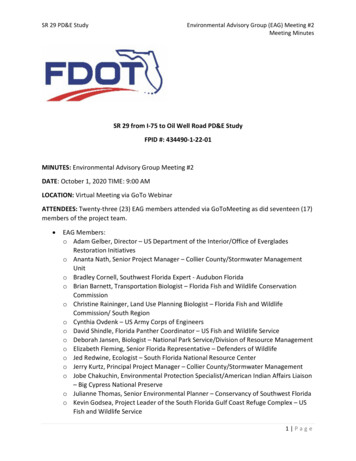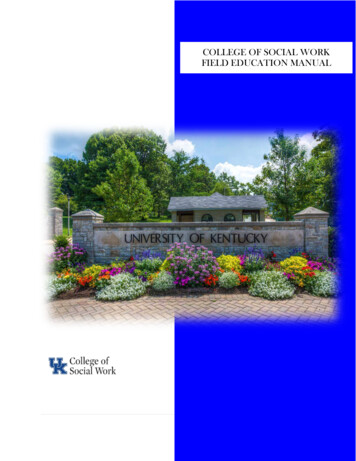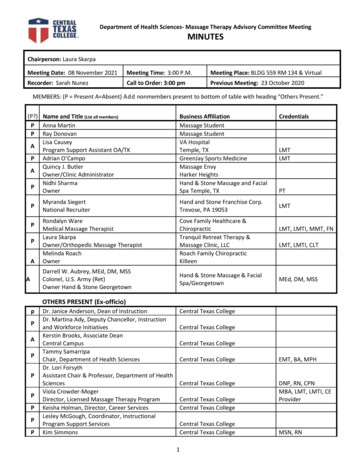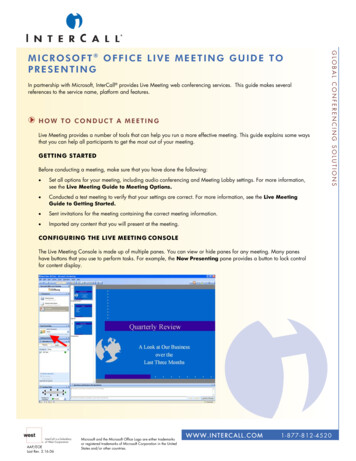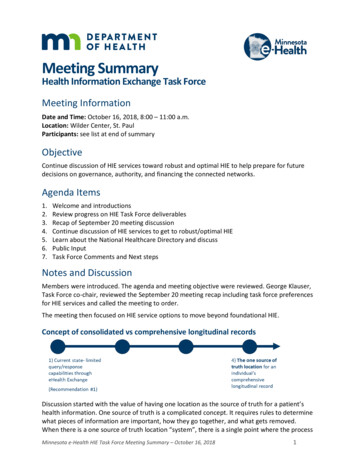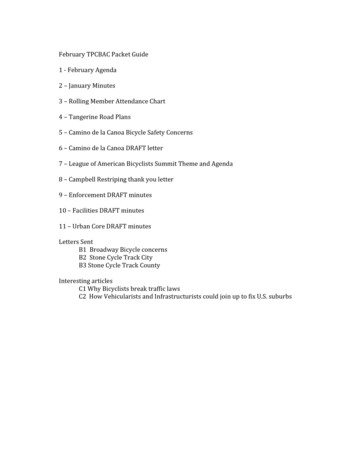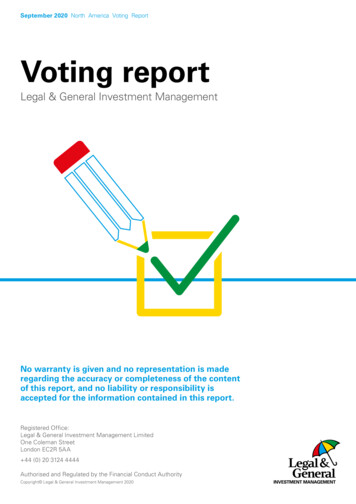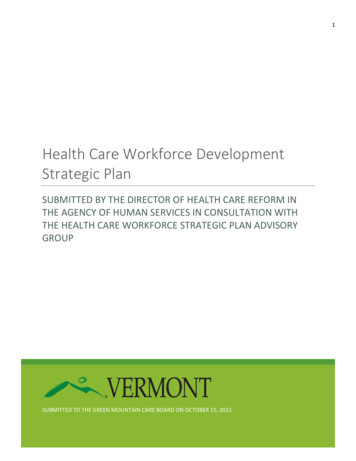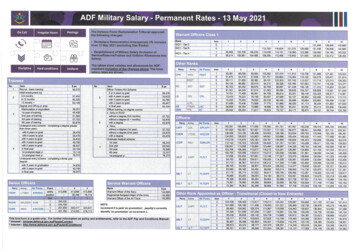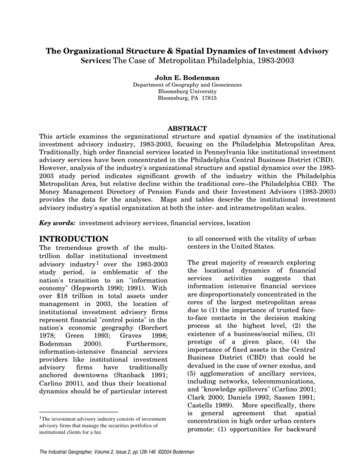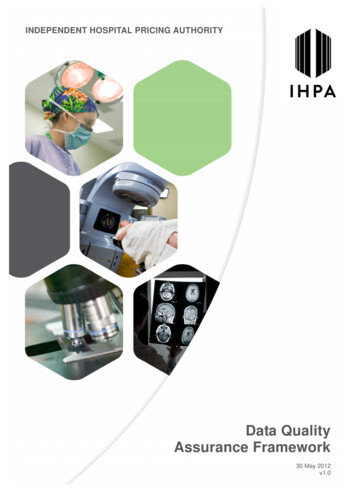
Transcription
Advisory Group Meeting #3 SummaryDuke Street in MotionThursday, 6/30/2022; 6:30 – 8:30 pmIn-person: Alexandria Police HQ Community Room3600 Wheeler Avenue, Alexandria VA 223041. AttendeesThe attendees are based on those who were in attendance during the introductory portion of themeeting and/or those who signed in. There were resident attendees who did not sign in, and whosenames were not therefore captured in the attendance log.NameAaron GofreedBob BrantCasey KaneErin WinogradGovan FaineLeslie CatherwoodMindy LyleNaima KearneyNawfal KalamWendy AlbertYvette JiangJim DurhamAmy StearnsBruce CainFran VogelConnie MassaroSusan Ross-O'BrienChristine HoeffnerChris ZiemannYon LambertWill TolbertJiaxin TongRavi RautBarbara MorenoLee FarmerJennifer KochJody FisherOrganization / DepartmentAdvisory Group (At-Large West of Quaker)Advisory Group (Development Community)Advisory Group (Transportation Commission)Advisory Group (Federation of Civic Associations)Advisory Group (At-Large West of Quaker)Advisory Group (At-Large East of Quaker)Advisory Group (Planning Commission)Advisory Group (At-Large West of Quaker)Advisory Group (Commission on Persons withDisabilities)Advisory Group (Small Business Owner)Advisory Group (DASH Advisory Group)Resident/DASH Advisory esidentCity of AlexandriaCity of AlexandriaWSPWSPWSPWSPVHBRHINeoNiche YesYesYesYesYesYesYesYesYesYesYesYesYesYesYesYes1
2. Meeting Summary Welcome and Agenda Overview (City/Leslie - 5 min)Approval of Meeting #2 minutes (Leslie – 5 mins)o Under the Guiding Principles portion of the minutes in the “Efficient” section (page 5),the following edits to the minutes were agreed to: Erin suggested that we strive to locate shared mobility devices in already“paved” places, not “pages” places. Erin suggested wording in the guiding principles that alternative mobilitydevices quoted by Wendy should be “placed” where there is already cement(not “places”).o Under the Guiding Principles portion of the minutes in the “Equitable” section, thefollowing change was made: Where 4600 Duke Street is referenced, that should be changed to “The Fields”.o Under the 2012 Plan Discussion section (page 7-8), the following change was agreed to: Jiaxin was quoted as saying the 2012 plan has a frequency of 7-minute busheadways, but the actual 2012 plan says 7.5 minutes. It will be noted as such inthe minutes. Erin noted that part of the 2012 plan was to reduce the “lane” width as opposedto “land” widtho Leslie provided some minor edits in Microsoft Word in advance of the meeting,including a few clarifying questions, these were responded to by the City offline. Alledits were accepted into the minutes, and the following questions were clarified: Correction was made to change the comment provider on the intent of theservice roads from Leslie to Erin Freedom of Information Act (FOIA) and Open Meeting Law must be met whengreater than 2 members discuss public business (taking out requirement). Leslie will facilitate the public comment period at the end of each AG meeting.(Leslie will not be responsible for facilitating the public engagement process onthis project overall.)o The AG expressed the desire to see all written public comments and responses –circulated at least a day in advance of the meeting. The City expressed the idea that thisshould be possible. Overview of Bus Rapid Transit (BRT) in general (Will/WSP – 5 mins) - Note: Overview slides willbe available to the AG and content of the overview is not all captured in these minutes.o Erin – When you have a curb lane, is there a local ordinance or state law thatdetermines how long a bus stays in that lane? If you are in the high occupancy vehicle(HOV) lane through Old Town during rush hour, you can only be in the lane for one blockbased on state law. If that is what BRT means for this corridor, then it is not tenable tohave dedicated curb-running lanes because we have so many residents and businessesalong the corridor. My section has clearly delineated blocks including residents andbusiness.o Aaron – Wouldn’t the curbside bus lanes require widening?2
oooo Will – Depends on location along the corridor. When converting a curb lane tobus lane, there is not necessarily a need to widen. We would also need toconsider traffic analysis before converting any traffic lane. If analysis showstraffic capacity issues, then we may need to look at the cost/benefit ofalternatives that involve widening at specific locations.Will – City would need to determine how they would want to regulate transit lanes thatare shared with turning vehicles (aka Business Access & Transit lanes). Erin – May be a state law. Leslie – Please let us know at the next meeting whether there are any existingapplicable laws about this (local or state). Lee – For Metroway, added regulations locally related to the center-runningexclusive bus lanes (not shared with turns). Erin – Does that apply only to center-running lanes or just dedicated lanes ingeneral? The City agreed to look into the details of the City ordinance related to the buslanes and report back.Community member – are you planning on widening the road? Will – We’re not planning on anything yet. We are in the development ofalternatives stage, and then those alternatives will be presented and evaluatedto the group.Bob Brant – Are there examples of BRT systems across the country where there are avariety of running way treatments? Will – Yes. That is part of the flexibility of BRT, different sections of a corridormay warrant different treatments. Jiaxin – For instance, Pulse has 50% exclusive bus lanes. The rest is sharedlanes/mixed traffic.Yvette Jiang – 2012 plan consists of only curbside business access & transit lanes, right? Will – Yes. Correct.Review of 2012 Plan (90 mins)o Leslie – We’re looking at the 2012 plan in its entirety. Things like the location of specificbus stations are too granular for today’s discussion. Not making decisions today;providing input. Nobody who wrote the 2012 plan is here today working on this.Nobody will take offense with anything we say.o Will – There will be an opportunity to discuss specific station locations in the future, butnot tonight.o Goal of the exercise and overview of materials (Will/WSP – 5 mins) Leslie – Our comments will be captured in two different ways. Note taker iscapturing comments as we speak tonight. We are also being recorded. Theother way is to capture written comments on the clipboard. Will – We do want written comments on the comment sheets provided. Therewill also be a 20-minute discussion tonight of key elements within each segmentof the corridor.3
ooErin requests being able to take comment sheets home and type upthoughts/responses. Answer: yes, this is perfectly fine.Presentation of Segment 1 key features (Will/WSP – 5 mins). Presentation slides can bemade available to the AG. Content not detailed in the minutes. Will – Not likely to head WB past Van Dorn as will be going into the LandmarkMall area instead. Mindy – Don’t we have preliminary roadway design plans for the areaaround landmark?o Yon – Yes.o Mindy – Should look at that for the design since it’s a significantdifference.o Will – The current plan for Landmark development will bereflected in the coming alternatives. Not reflected in the 2012plan.Discussion of Segment 1 (Leslie/AG – 20 mins) Will – We will answer questions or clarifications about the 2012 plan withunderstanding that this is conceptual and designed by another team. Segmentdiscussions should be around 15-20 minutes to give equal time to eachsegment. Bob Brant – Was the 2012 design within the existing ROW or was more ROWrequired? Chris – Mostly within existing ROW for Segment 1. Jiaxin – There is some ROW impact in Segment 2. Aaron – It feels like Segment 1 is not too hard to convert to curbside bus lanes. Mindy – Lots of bus stops are just a pole in a narrow strip (measured as2 feet, 4 inches) between mainline Duke Street and service road Erin – South Pickett Street is a commercial street with a tremendous amount oftraffic. This is where we need to understand how long a car can be in adedicated bus lane. If cars can stay in the dedicated bus lane for only one block,people (traffic) will stack up in either bus lane or general lane. Aaron – Could there be barriers in certain spots? Mindy – This is a good location for a center BRT? Bob – More ROW here (width) than in other spots – already six lanes. Will – We want to look at curbside, center, and mixed-traffic alternatives for thissegment (and other segments). Mindy – This part of Duke currently has a fence that means you can’t cross. Aaron – Center running construction will take longer Yvette – The current roadway section in Segment 1 should be wide enough toaccommodate lane changes shown in the 2012 plan. Will – Any alternative that we study will have a significant amount of trafficanalysis and we’ll be able to compare how each alternative performs. Looking atthe level of service in vehicle delay at intersections and what is the trafficqueuing.4
Erin – What modeling and simulation are you going to use for that?Where are you going to get the data?o Jiaxin – We collected the data in May 2022. We also have datafrom 2018. Working on developing the baseline volume that ismost representative of typical conditions.o Erin – Pickett is a critical intersection.Yvette – Cameron Station has fences between the house and road. Curbsidewould be best for access to the library. For this segment curbside businessaccess & transit makes sense.Leslie – Hearing some interest for curbside dedicated lanes. Some interest incenter bus lanes. What do people think about the bike lanes as shown in the2012 plan? Nobody expressed support for the lanes as shown in the 2012 crosssection. Aaron – We have alternatives. Holmes Run Trail connects toEisenhower. If we add bike lanes on other roadso Mindy – Lots of bike commuters use this corridor.o Aaron – Could repair existing bike lanes and sidewalks onEisenhower which is a good connection to Old Town.Opportunity to add bike lanes on other roads in the network tohelp with connectivity. (Quaker, King, other connections to OldTown)o Mindy – lots of bike commuters using this corridor AM/PM; notjust Old Town. You see a lot more when you are on foot than ina car. You need a bike connection along Duke Street. Casey – Unprotected bike lane is not good. I would like to see protectedbike lanes along Duke Street. This should be explored in the alternativestage as a starting point. This is the route between Walker and Jordonvia Duke Street and then Holmes Run Trail. Meandering paths are lessdesirable than a direct path if achievable. Mindy – 5.5 million square feet going in at Landmark. Businesses willhave 4000 employees. Some of those people will be biking. Bob – It must be safe and accessible. The 2012 plan is not safe for biketravelers on Duke Street. Leslie- Hearing support for bike infrastructure. Some questions as towhether that connection would be on Duke Street or an alternate route.If we have 2-directional dedicated bike lanes down Duke Street, that isnice (like Pennsylvania Avenue and K Street – signals for bicycles). Aaron – may need to consider speed limit reduction if including bikelanes on Duke Street. Pennsylvania Avenue speed limit is 25 mph. Will – We do have a subconsultant on the team specifically looking atbike connectivity and how to include that, either on the street or aparallel route. Good to hear confirmation of interest. Leslie – Safe bike lanes are a priority for the group.5
oLeslie – Would want to ensure substantial safe pedestrian access to each busstation, wherever they are located. Erin – You must consider what happens if the stops do not line up withcurrent traffic light locations. You would then need to consider theimpact on how the traffic flows.o Will – That would be part of our traffic analysis. Either extraphases for pedestrians or extra signalized crossings.o Will – We will also assess corridor end-to-end travel timeanalysis for both transit and general-purpose traffic.Erin – Travel times are different based on whether you are in the right lane orleft lane. Will need to consider vehicular traffic.Bob – Looks like crosswalks are pretty evenly spaced between stations.Discussion of difference between existing stop locations and 2012 stationlocations shown.Yvette – Do we have any plans to improve the access to Ben Brenman Park? There is WB access to the park Leslie – Need to make that access clearer.Leslie – Are there 3 lanes of auto traffic WB and 2 eastbound in the typicalsection graphic? Will – The third lane WB is just a turn lane. This could be present ineither direction depending on where turn lanes are at an intersection.Casey – Some opportunities to narrow lane width. We should also look atreducing the speed limit not only in this segment but the entire corridor. Alsogives opportunities to have additional width for sidewalks, buffers, etc.Mindy – reducing lane widths can help reduce speedsJiaxin – Are we supporting bike access from the mall to the park? Mindy/Casey – Yes, because of the huge work center that will be at themall. Aaron/Erin – No Overall – Mixed reviews on need.Aaron – Duke Street is very residential in sections. People usually go from oneplace to the other (A-B) Mindy – Will be a hospital and other offices. Casey – disagrees – make several stops (office, grocery), not always A toB. Chris – Different people ride for different reasons Aaron – how many people would we be helping with bikes vs havingmore infrastructure than needs to be here Will – our subconsultant will be providing more information on bikedemand and connections. We can continue bike discussion insubsequent segmentsPresentation of Segment 2 key features (Will/WSP – 5 mins) Presentation slides can bemade available to the AG. Content not detailed in the minutes.6
oDiscussion of Segment 2 (Leslie/AG – 20 mins) Leslie – What does the advisory group think of the reversible travel lane idea? Erin notes that reversible lanes would require overhead signage. Will –correct, would be a need to manage those lane assignmentsdynamically. Casey – Non-starter. Reversible lanes are dangerous and confusing formotorists. Not to mention the infrastructure required. Everyone agrees that we should not be using reversible travel lanes. Leslie – What does everyone think about the lack of bike lanes? Erin – There is a bike route that people use off Duke Street on WheelerAvenue. This is the bypass for Duke Street. Casey – May need to consider a robust shared use path on one side orthe other. Sacrificing traffic/transit lane for bike lanes for this sectiondoes not make sense. Mindy – Even the sidewalks in this section are very narrow. Expand bikeand pedestrian facilities. Casey – To take away anything from the travel lanes for bike laneswould be hard. Yvette – Is there any logic behind the width of turn lanes? 13 or 12?Same with through travel lanes – some are 11, some 12? 10 as idealsize. Can we condense each lane and leave a bike lane?o Will – Generally, we work with transit agencies and the City toestablish the desirable and absolute minimum lane width forbus lanes and travel lanes and that helps inform our alternativelayouts. We have designed 11-foot bus lanes; usually driven bymirror-to-mirror width, comfort of the City and the transitagency with lane width for the bus operators. Erin – Wheeler Ave is industrial. Dozens of 18-wheelers use Wheelerevery day and turn near my neighborhood. If you narrow the lanes,what is the impact on the 18-wheelers?o Will – That would have to be a part of establishing the designcriteria and design vehicle criteria for areas along the corridor. Leslie – Interest in bike connectivity between segments. I am veryopposed to a bike lane that just ends. If we are going to have analternate route off Duke Street, having bicycles take a confusing routewith lots of turns, people will not use it. To me, that is not a viablealternative. If it is clearly labeled and well-paved, that is an option. Leslie – What do we think of pedestrian access. Yvette – 10 to 12 feet as ideal width for a sidewalko Erin – Infeasible to have 12-foot-wide sidewalks in that section.We need to widen but I do not know if we can get a sidewalkthat wide.o Chris – we are hearing that wider sidewalks are desired. Mindy – Are we sure the retaining walls are not on City ROW?7
o Leslie – That’s something we should find out for futureconversations.o Will – We will be establishing where the R/W lines are and thereis scope for a detailed survey upcoming.Leslie – What do we think about the bus lane on the curb?o Erin – Only place to put it but there are too many people thatneed to access their homes and businesses.o Mindy – Disagree. If we are doing true BRT where we arereducing waiting times and trying to encourage more people toride, we need fully dedicated bus lanes down the corridor. Donot stop and start them.o Erin – There’s very little traffic between Jordan and the SunriseLiving Center.o Aaron – Bus operating for free. Will it stay like that? Morepeople will ride if it’s free. Could help ridership and justify buslane in the corridor.o Will – We do not have to decide tonight about dedicated buslanes, we do not have the information yet to evaluate. One ofthe flexibilities of BRT is to adapt to context in different sectionsof the corridor.o Casey – Ideal is to have dedicated bus lanes. May be a challengein some locations.o Leslie – Hearing interest in curbside lanes in this segment.o Bob – Would be interested in seeing what the different optionslook like, what cost/benefits will be of dedicated lanes or hybridapproach.o Jiaxin – Bob asked about the impact on ROW. In this segment,there is an impact to the commercial service road. Also, achange to the access to Duke Street Service Road at JordanStreet.o Discussion of traffic from Duke Street to Jordan Steet via thefrontage road. Erin – There is a lot of traffic in the AM. School busroute. Can get stuck behind a bus or row of buses. Theaccess road keeps Duke Street moving – access roadbacks up to make turn onto Jordan. Erin - There are service roads with homes frontingthem. Yvette – Service roads that back up to residentialhouses are more important than commercial frontageroads with other parking options – there is a parking lotin front of the stores. Erin – That’s also the Fields parking lot.8
ooNaomi – There is also a bus stop on the serviceroad for Metrobus and a bus stop for DASH nextto Duke Street, which is confusing. Leslie – Group is flagging Jordan Street intersection as aplace that needs to be addressed with multiple localroutes, separate bus stops, and complex traffic pattern.Leslie – Frontage/Service Road. Hearing some concerns about theresidential areas. There seems to be general interest in protecting thehomes and frontage roads that access them.o Bob – How many homes would be impacted? Casey – At least14 would be impacted.o Chris – existing frontage roads are wider travel lane withparking, 2012 plan shows narrower frontage roads with noparking.o Erin – That is a concern because some people park their cars onthe frontage roads due to lack of parking, including at the Fieldsparking lot, and there would be an overflow of parking intoneighborhoods.o Mindy – May need to have separate meetings with theresidents like The Fields to get their input.o Will – There will be public outreach opportunities for the groupsto speak about some of these concerns.o Leslie – Hearing some consensus around protecting the frontageroad for the residences. Maybe even keep their parking.Preserve access. Mindy – we need more information to evaluate theimpactso Leslie – Mixed views on frontage roads that access thebusinesses. Some feel they should stay. Some feel there shouldbe more flexibility.o Yvette – Sidewalks are narrow and inconsistent betweenfrontage roads and Duke Street.o Leslie – Improving sidewalk access and consistency is importantthroughout the entire corridor.Presentation of Segment 3 key features (Will/WSP – 5 mins) Presentation slides can bemade available to the AG. Content not detailed in the minutes.Discussion of Segment 3 (Leslie/AG – 20 mins) Leslie – Not a fan of unprotected bike lanes. The group would like consistencythroughout the corridor. Will – Some discussion of routing down Diagonal or Callahan. Terminus is KingStreet Metro Station, but route is not yet determined. Looking at circulationoptions.9
Aaron – Discussion of how to transition buses from curbside lanes to a left turnand eventual access to King Street Metro Station.Erin – Need to understand the rules for vehicles in a bus dedicated lane. Lots ofpeople are turning right to get into businesses. What is the allowable distancefor a turning vehicle to be in a curbside bus lane?Aaron – This could be a good segment for the center running bus lanes.Casey– Center lanes make a lot of sense here. Access from elevations on thenorth side of Duke Street is tough.Leslie – There’s already a median there. Fairly large. Erin – There are trees there (on the median).Naomi – No sidewalk along Duke Street, located on the frontage roadLeslie – The West Taylor Run Parkway intersection is horrific for pedestrians.Casey – Need to make Telegraph safer for pedestriansNaomi – There are only two bus stops on the south side of the street. People arecrossing where there is no crosswalk. Will – confirmed that we saw this duringcorridor tour frequently in a short span of time.Leslie – Hearing interest in center bus dedicated lanes in this section. Significantimprovements to pedestrian safety and crosswalks. Moving pedestrian crossingsto where people are actually crossing.Jiaxin – There is a huge elevation change from Duke Street to frontage road,making it more difficult for pedestrians to access the existing bus stops.Bob – How much ROW is required for center lanes vs. curbside business vs.what’s out there today? Question for the future. Will – this will be looked at aswe lay out alternatives.Erin – Could you also help us and point out whether each option would impactthe tree canopy? There are also lots of utility poles – would we have to pay, orwould Dominion be forced to pay to underground or move utilities?Will – We will look at whether utility relocation is reimbursable and what utilityrelocation costs would be and whether there is physical room to put therelocated utilities. Also, will need to look at City policy about tree mitigation andprotection.Leslie – In this section, there is very little tree canopy along Duke Street. Soundslike the group is interested in increasing the canopy along Duke Street corridor.Casey – This project is not about having lots of asphalt, but what makes thecorridor more pleasant to walk along. What are the options to improve thestreetscape (Columbia Pike is an example)?Aaron - Any options to have pedestrians walk in the center? Casey – Mentioned center walkways being uncomfortable. Leslie – May need infrastructure to encourage people to NOT walkdown the center. Will – showed examples of center station and crosswalk connections,and how other corridors have tried to improve safety in that regard.10
o Naomi – Telegraph Road interchange ramp crossing for pedestrians (four ofthem) - “that’s why I don’t walk with my kids”. Will – agree this has been notedin corridor tour, tough crossings.Naomi – Lots of people on Duke Street are trying to get to the Patent Office onDulany Street. These ramp crossings are challenges to that access. Currentlysome stations are accessed by different routes at various times. Casey – Would still be regular buses that are able to use this section. Will – We will be looking at transit service planning as part of thisprocess. Leslie – Also lots of other businesses at Carlyle to consider.Erin – Mark Schnaufer said there was the potential to get rid of line 30 becauseof the BRT. My neighborhood would have a problem with that. Serves a muchlonger length and stops much more frequently.Will – High level, on every BRT corridor that goes in, there is discussion of whatto do with underlying routes and how those function with the BRT. No differenton this project. BRT looks to have known commodity station where the bus willalways stop.Yvette - Pedestrian island/refuge as a concept to consider. Erin – refuge is araised/protected area in the middle for pedestrians to cross major/wide roads intwo stages if necessary.Will – Group did an excellent job discussing these segments in 20-minute increments.There was a lot to discuss, appreciate the group’s time in doing this. Leslie – All should send comments by Monday the 11th. Comments should besent to Chris Ziemann. His email information will be provided.Electronic polling evaluation of 2012 plan (Barbara/Jennifer – 10 mins)o Skipped for timing purposes.Establish next meeting date – target 3rd week of August (Leslie – 5 mins)o Thursday, August 18 Yvette has an exam that day. Leslie indicates that the 3rd Thursday of every month is the target.o The primary agenda on August 18 will be to review draft schematic alternativesdeveloped for the corridor. Coming out of that meeting there will be an opportunity toadjust those schematic alternatives based on AG conversation and then present them tothe larger public in mid to late September.o Erin - Who is selecting the preferred alternative? Chris – this group is helping craft the preferred alternative Jiaxin/Will - In November, will narrow the alternative based on AG/Publicfeedback and will develop up to 2 corridor-wide alternatives to TC/CC to carryforward for refinement and further evaluation.o Mindy – Will we be going out to the community to get input? Jenny – Yes, like the previous phase of engagement.11
oo Leslie – Schedule is in flux. Please reserve the third Thursday of every month. Input fromtoday and input we send by July 11 will be used to create the proposed alternatives.They won’t look like the proposed alternatives in the 2012 plan.Yvette – Zoom for the August meeting? Leslie – Yes. This meeting was an exception to the rule. Future meetings willhave an online component. AG is encouraged to attend in person because ithelps to facilitate the dialogue.Public Comments (2 Min per speaker, 10 minutes max)ooooFran Vogel – President of Strawberry Hill CA. Service roads are extremely critical to ourneighborhood. As many know, when traffic backs up from the ramp at Telegraph, itbacks up past Early Street, where I live. It can get quite challenging to get out of theneighborhood. Service Roads are critical to being able to have access that mitigates thiscongestion. Another critical thing is that people do have houses that front service roads.Do not have parking at all houses along service road. Especially along the south sidewhere the duplexes are. School buses stop on the service roads at the Fields. Big busstop for children at the Bank of America. Ft Williams Parkway is also an entry point alongthe service road at Duke Street – also Strawberry Run urban stream in that section. I ampleased to hear that you will not do the reversible lanes – that would be very disruptiveto the neighborhood. I want to stress the importance of the service roads to the peoplethat live in that section. They are critical.Amy Stearns – Society Hill HOA, corner of Duke and South Early. August 2 is nationalnight out event. Alexandria residents have cookouts and barbeques. Could be anopportunity for outreach to frontage road communities. When DASH made changes lastyear to increase service frequency and go fare free, it has not even been a year, but I amsure they have a lot of data. This group would benefit from knowing what they found –is ridership going up? Are there lessons to learn? COVID complicates things related totransit data. Will – we have made a data request to DASH.Jim Durham – DASH AC – Pedestrian safety. City has a policy to eliminate slip laneswherever feasible. In this corridor there are several. WB Duke to Van Dorn. Duke atSouth Early. Others as well. Thinking about vehicles moving up the ramps withoutstopping and how that is a challenge to pedestrians.Jeanie Jacob – President of Seminary Ridge CA. I’m a little confused. Printed informationfrom 2012 study/reports. Nowhere did it show bike lanes on there. Your presentation of2012 did show bike lanes. The report said a study would have to be done before bikelanes were considered. Will – Not sure if a study was done. We are doing a study of bike connectivityalong the corridor. Jiaxin – Bike lanes were part of the design concept. Jeanie – 2012 Council meeting said study should be completed before bike lanesare considered. Mindy – It is only a concept at this point. Not a proposed design. Studies arebeing done. Jiaxin – We are collecting data next week for the bike analysis.12
oooo Will – Should know more by the fall.Leslie – can expect by the end of the year. Will – Certainly before a locally preferred alternative (LPA).Bruce Kaine – Lived in the corridor for 20 years, Taylor Run and Duke Street. I see lanewidths at 10’. Need to consult with Alexandria Fire. Tractor Trailers also need to be ableto use this. Moving at high speed on a 10’ street scares me to death. Lots of people ofcolor who live along the service roads who are dependent on their automobiles foraccess to work. How are we ensuring that outreach gets to a wide demographic ofpeople who are dependent on different modes of transportation along the corridorPeople use service road to park their vehicles. I applaud the use of buses and bikes, butwhere will people be going along this corridor who use the bus? Where are the largeemployers? Landmark is close to I-395. N/S transit corridor I understand. E/W not somuch.Connie Masaro –
3600 Wheeler Avenue, Alexandria VA 22304 1. Attendees The attendees are based on those who were in attendance during the introductory portion of the meeting and/or those who signed in. There were resident attendees who did not sign in, and whose names were not therefore captured in the attendance log. Name Organization / Department Attendance
